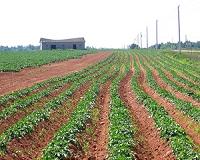 |
Madison WI (SPX) Jan 31, 2011 Soybean production has continued to increase in the Northeast United States with more and more first time growers planting the crop and many experienced growers planting alongside corn crops. To save on time and expenses, some farmers plant soybeans with a corn planter in 30-inch rows instead of 7.5-inch rows with the regularly used grain drill. Dr. William Cox, a Cornell University scientist, investigated the response of two soybean varieties in row widths of 7.5, 15, and 30 inches at four seeding rates in a study funded by a USDA Hatch grant. Cox measured emergence rates of soybean, growth, yield components, and seed yield of soybean to determine if soybeans can grow rapidly enough in 30-inch rows compared to smaller rows during the northern latitudes' shorter growing season. Previous research suggests soybeans grown in northern latitudes yield best in rows of less than 15 inches. However, the high price of soybean seeds may influence growers to use the corn planter because of its uniform seed depth and distance between seeds in a row reducing seeding rates. Cox discovered that soybeans grown in 30-inch rows had approximately 15% lower biomass than soybeans grown in 7.5 inch rows. The lower biomass contributed to 14% fewer pods, 9% fewer seeds, and 15% lower harvest yield. "What this study shows is that the soybean yield potential is about 15% greater when drilled in 7.5-inch rows compared to when planted with a corn planter in 30-inch rows in this Northeast environment," says Cox. Nevertheless, Cox stresses that the conclusions are based on an experiment done in a controlled setting and should be interpreted as such. "Care must be taken in interpreting the results of this small plot study, where weed escapes were controlled by hand-weeding ,and Roundup and aphicide applications were made so as not to run over soybean plants in any of the row widths," he adds.
Share This Article With Planet Earth
Related Links American Society of Agronomy Farming Today - Suppliers and Technology
 Toward Controlling Fungus That Caused Irish Potato Famine
Toward Controlling Fungus That Caused Irish Potato FamineWashington DC (SPX) Jan 21, 2011 Scientists are reporting a key advance toward development of a way to combat the terrible plant diseases that caused the Irish potato famine and still inflict billions of dollars of damage to crops each year around the world. Their study appears in ACS' bi-weekly journal Organic Letters. Teck-Peng Loh and colleagues point out that the Phytophthora fungi cause extensive damage to food ... read more |
|
| The content herein, unless otherwise known to be public domain, are Copyright 1995-2010 - SpaceDaily. AFP and UPI Wire Stories are copyright Agence France-Presse and United Press International. ESA Portal Reports are copyright European Space Agency. All NASA sourced material is public domain. Additional copyrights may apply in whole or part to other bona fide parties. Advertising does not imply endorsement,agreement or approval of any opinions, statements or information provided by SpaceDaily on any Web page published or hosted by SpaceDaily. Privacy Statement |